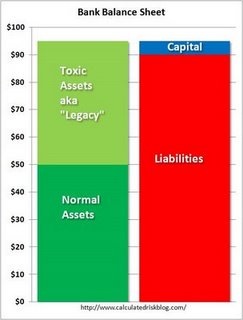Calculate Risk has a post with some very instructive charts comparing the effects of various attempts to bail out banks as they affect the bank’s balance sheets.
Calculated Risk: Bank Balance Sheet: Liquidity and Solvency, Part II
In the previous post, I tried to present a conceptual overview of a liquidity crisis using a bank’s balance sheet: Bank Balance Sheet: Liquidity and Solvency, Part I. Note: I combined various types of financial institutions to illustrate a few points.
As we continue the story, the bank has suffered some losses, but the bank run has been halted by the efforts of the FDIC (increasing insurance limit), or the Fed (by providing liquidity).
This time we look at the bank’s assets. What I’ve labeled as “normal assets” are various categories of assets, perhaps commercial & industrial (C&I) loans, consumer loans, and others. Although the charge-offs are increasing for all of these loans during the recession, these assets have a market value or otherwise are in OK shape.The larger problem is the toxic assets (now known as legacy assets). These are mostly related to residential real estate, but there are many other toxic loans (Construction & Development, foreign loans, LBO PE loans, etc.)
The banks are facing huge additional losses for these legacy assets, and these losses will make some banks “balance sheet” insolvent (liabilities will be great than assets). However, the bank is not insolvent in the business sense, because the bank can still pay their debts as they come due — at least for now.
…
